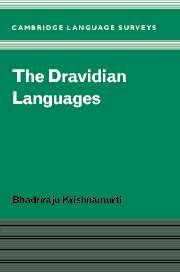Book contents
- Frontmatter
- Contents
- List of illustrations
- List of tables
- Preface
- Acknowledgements
- Note on transliteration and symbols
- List of abbreviations
- 1 Introduction
- 2 Phonology: descriptive
- 3 The writing systems of the major literary languages
- 4 Phonology: historical and comparative
- 5 Word formation: roots, stems, formatives, derivational suffixes and nominal compounds
- 6 Nominals: nouns, pronouns, numerals and time and place adverbs
- 7 The verb
- 8 Adjectives, adverbs and clitics
- 9 Syntax
- 10 Lexicon
- 11 Conclusion: a summary and overview
- Bibliography
- Index of reconstructions with glosses
- General index
1 - Introduction
Published online by Cambridge University Press: 22 September 2009
- Frontmatter
- Contents
- List of illustrations
- List of tables
- Preface
- Acknowledgements
- Note on transliteration and symbols
- List of abbreviations
- 1 Introduction
- 2 Phonology: descriptive
- 3 The writing systems of the major literary languages
- 4 Phonology: historical and comparative
- 5 Word formation: roots, stems, formatives, derivational suffixes and nominal compounds
- 6 Nominals: nouns, pronouns, numerals and time and place adverbs
- 7 The verb
- 8 Adjectives, adverbs and clitics
- 9 Syntax
- 10 Lexicon
- 11 Conclusion: a summary and overview
- Bibliography
- Index of reconstructions with glosses
- General index
Summary
The name Dravidian
Robert Caldwell (1856, 3rd edn, repr. 1956: 3–6) was the first to use ‘Dravidian’ as a generic name of the major language family, next to Indo-Aryan (a branch of Indo-European), spoken in the Indian subcontinent. The new name was an adaptation of a Sanskrit term draviḍa- (adj drāviḍa-) which was traditionally used to designate the Tamil language and people, in some contexts, and in others, vaguely the south Indian peoples. Caldwell says:
The word I have chosen is ‘Dravidian’, from Drāviḍa, the adjectival form of Draviḍa. This term, it is true, has sometimes been used, and is still sometimes used, in almost as restricted a sense as that of Tamil itself, so that though on the whole it is the best term I can find, I admit it is not perfectly free from ambiguity. It is a term which has already been used more or less distinctively by Sanskrit philologists, as a generic appellation for the South Indian people and their languages, and it is the only single term they ever seem to have used in this manner. I have, therefore, no doubt of the propriety of adopting it.
(1956: 4)Caldwell refers to the use of Drāviḍa- as a language name by Kumārilabhaṭṭa's Tantravārttika (seventh century AD) (1956: 4).
- Type
- Chapter
- Information
- The Dravidian Languages , pp. 1 - 47Publisher: Cambridge University PressPrint publication year: 2003
- 1
- Cited by

